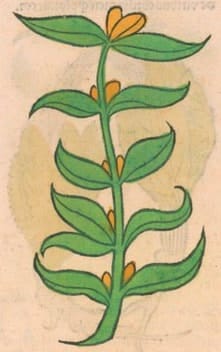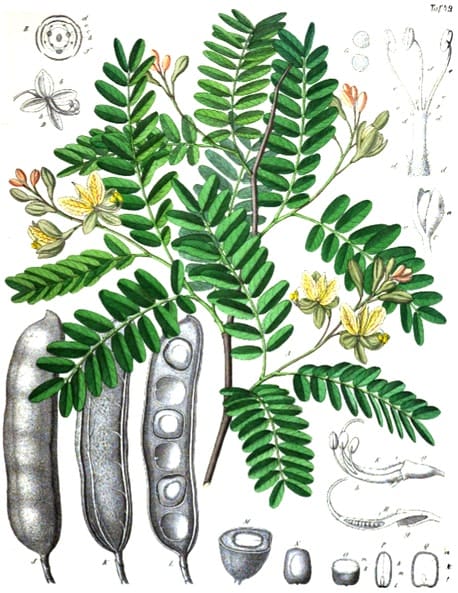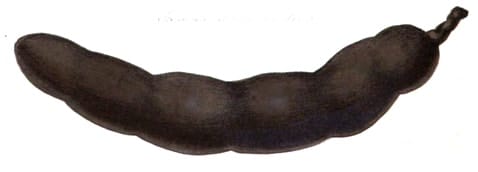Tamarindus, Tamarind
Chincha (Ayurveda)Tamar Hindi (Unani)
 Ortus Sanitatis, Meydenbach, 1491
Ortus Sanitatis, Meydenbach, 1491 Tamarind tree
Tamarind treeAtlas der officinellen pflanzen (2), Felix, 1899
 Tamarind Seed pod, Plantæ Utiliores, Burnett & Burnett, 1842
Tamarind Seed pod, Plantæ Utiliores, Burnett & Burnett, 1842 Members CLICK HERE for the PRO VERSION
Members CLICK HERE for the PRO VERSIONBotanical name:
Tamarindus indica
Parts used:
Fruit; Fruit Pulp
Temperature & Taste:
Cool, moist. Sweet, Sour
Classifications:
2B ATTENUATERS. 2S. STRENGTHENING
3B. FEBRIFUGE & ANTIPYRETIC
4e. STOMACHIC
TCM:
B. Clear Heat
Uses:
1. Clears Heat and Bile:
-Gently purges Phlegm and Bile
2. Clears Heat, Loosens the Bowels:
-gently purges
3. Benefits the Stomach, Increases Qi:
-Relieves Vomiting and Nausea
4. Externally:
-applied as a poultice for inflammations
Dose:
Decoction: ½–2 oz.
Pulp of Tamarind: ½–1 dram
Correctives:
… available in PRO version
Substitutes:
… available in PRO version

Main Combinations:
1. To clear Heat and Bile:
i. Tamarind with … available in PRO version
ii. boil Tamarind in … available in PRO version
iii. Tamarind with … available in PRO version
iv. Tamarind with … available in PRO version
v. Tamarind with … available in PRO version
2. Clear Heat from Lungs, Stomach or Liver, Tamarind with … available in PRO version
3. To purge Phlegm and Bile, or mixed Humors, Tamarind with … available in PRO version
4. As a laxative:
i. Tamarind pulp with … available in PRO version
ii. Tamarind pulp (3 oz.), … available in PRO version
iii. Tamarind pulp with … available in PRO version
iv. Tamarind pulp (3 oz.), … available in PRO version
v. Tamarind pulp (1 ½ oz.), … available in PRO version
vi. Especially used for children: Tamarind pulp (2 oz.), … available in PRO version
vii. Tamarind pulp with … available in PRO version
viii. Tamarind pulp with … available in PRO version
ix. Pulp of Tamarind, … available in PRO version
x.. Pulps of Tamarind, … available in PRO version
5. As an Enema:
i.. Tamarind pulp (1 ½ oz), … available in PRO version
Major Formulas:
Decoction to Cool
Decoction to Expel Bile (Andernacus)
Decoction of Fruit and Flowers
Decoction of Myrobalan (Mesue)
Syrup of Dodder of Thyme (Mesue)
Electuary of Prunes (Diaprunis lenitiva) (Nicholas)
Catholicum (Diacatholicum) (Nicholas)
Cautions:
1. Not used in Cold bodies
2. Long-term use has been associated with Impotence (Unani)
Main Preparations used:
Pulp of Tamarinds, Electuary Diaphoenicon
|
‘There would appear to be little doubt that the Tamarind tree is a native of some part of India, probably the South. It is found in a cultivated or semi-cultivated state almost everywhere, and the fruit, besides being an important article of diet, is valued by the Hindus as a refrigerant, digestive, carminative and laxative, useful in febrile states of the system, costiveness, &c. The ashes of the burnt suber are used as an alkaline medicine in acidity of the urine and gonorrhoea, the pulp and also the leaves are applied externally in the form of a poultice to inflammatory swellings. The Sanskrit names of the Tamarind are Tintidi and Amlika. The author of the Makhzan-el-Adwiya describes two kinds of Tamarind, viz., the red, small-seeded Guzerat variety, and the common reddish brown. The first is by far the best. Mahometan physicians consider the pulp to be cardiacal, astringent and aperient, useful for checking bilious vomiting, and for purging the system of bile and adust humours; when used as an aperient it should be given with a very small quantity of fluid. A gargle of Tamarind water is recommended in sore throat. The seeds are said to be a good astringent, boiled they are used as a poultice to boils, pounded with water they are applied to the crown of the head in cough |
and relaxation of the uvula. The leaves crushed with water and expressed yield an acid fluid, which is said to be useful in bilious fever, and scalding of the urine; made into a poultice they are applied to reduce inflammatory swellings and to relieve pain. A poultice of the flowers is used in inflammatory affections of the conjunctiva; their juice is given internally for bleeding piles. The bark is considered to have astringent and tonic properties. (Makhzan-el-Adwiya.) The natives consider the acid exhalations of the Tamarind tree to be injurious to health, and it would appear that the cloth of tents allowed to remain long under the trees becomes rotten. Plants also are said not to grow under them, but this is not universally the case, as I have often seen fine crops of Andrographis paniculata and other shade loving plants growing under Tamarind trees. The word ‘Tamarind’ appears to be derived from the Arabic Tamar-Hindi (Indian date), and it was doubtless through the Arabians that a know ledge of the fruit passed during the Middle Ages into Europe, where, until correctly described by Garcia d’Orta, it was supposed to be produced by a kind of Indian palm. (Vegetable Materia Medica of Western India, Dymock, 1885) |
